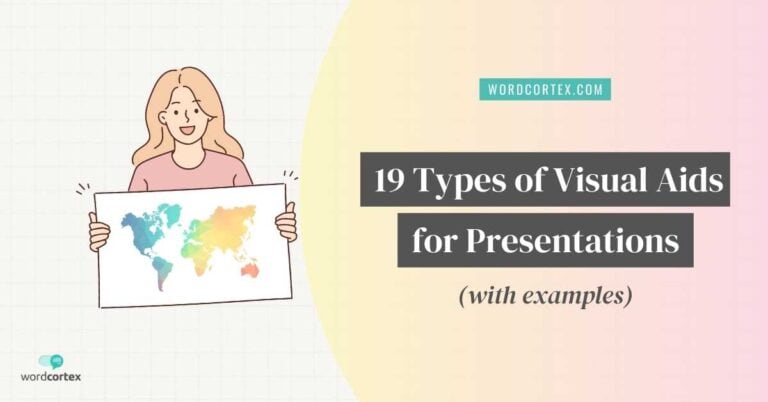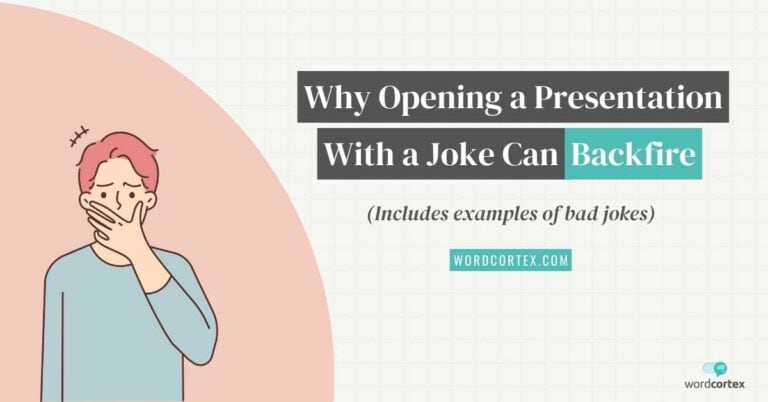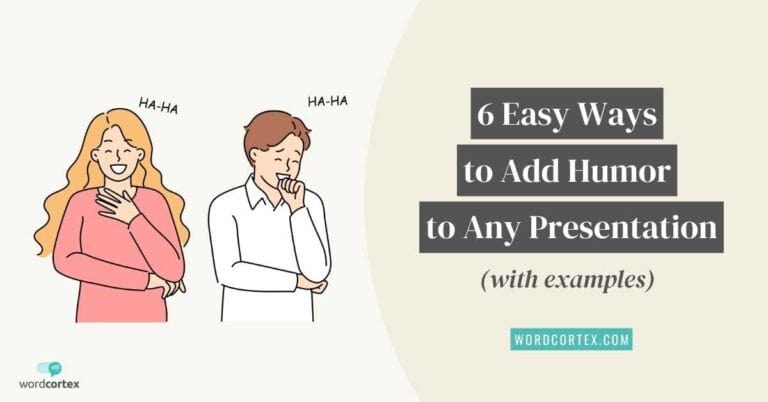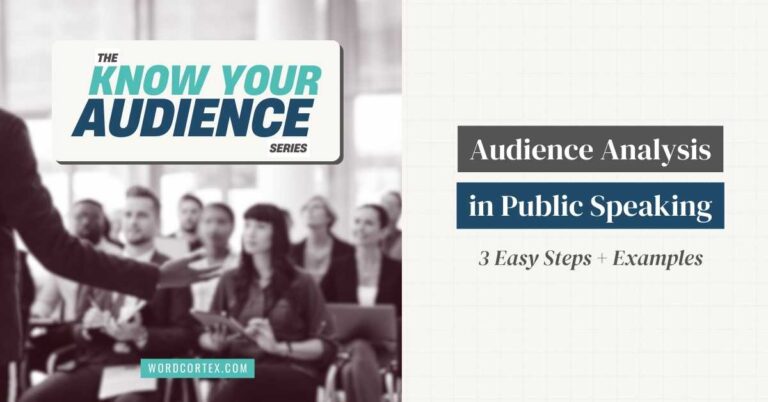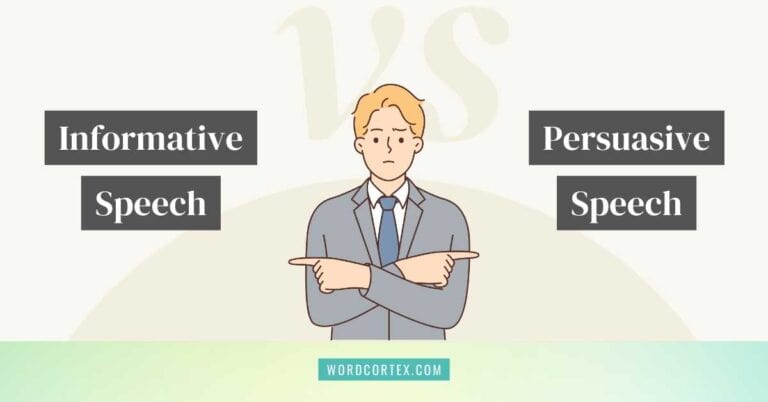16 Real Informative Speech Examples: An In-Depth Analysis
If you’re looking for top-quality informative speech examples, you’re in the right place!
When I was on the lookout for informative speeches to learn from, I noticed that most articles only seem to provide theoretical ideas or hypothetical examples without showing any real speeches in action. How frustrating!
Well, I decided to take matters into my own hands and spent hours digging through the internet to find these informative speech gems.
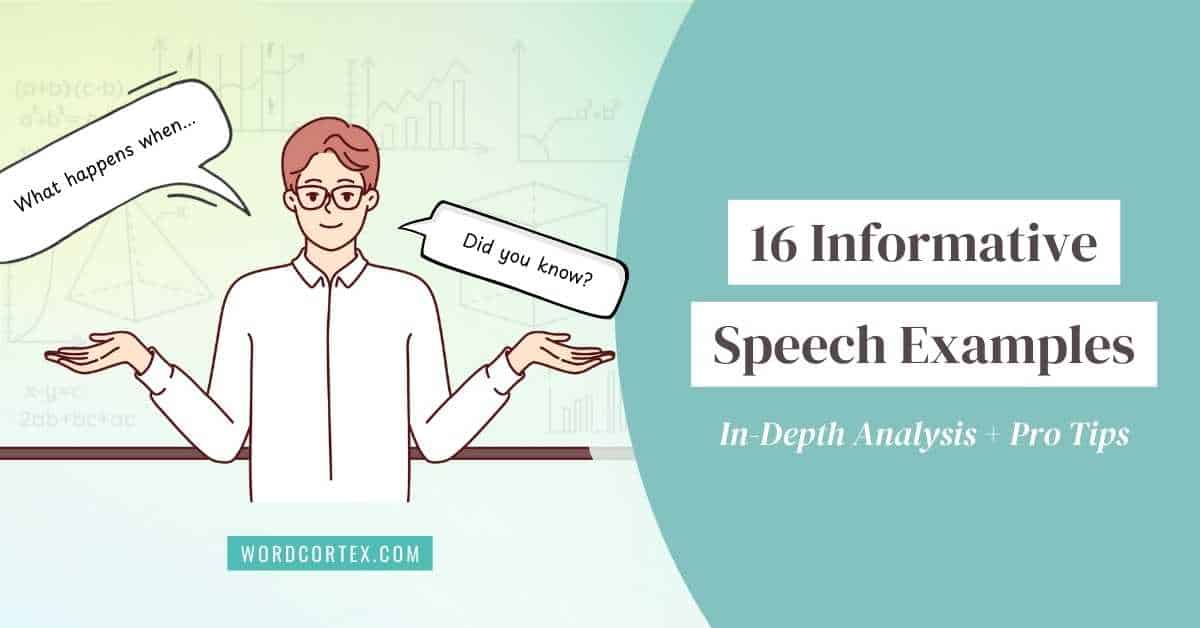
In this article, you’ll find 16 real-life examples of informative speeches, each analyzed in detail to reveal what makes them effective.
You’ll also learn about the different types of informative speeches — from explanatory and demonstrative to descriptive and definitional.
By the end, you’ll know exactly how to make any topic engaging and impactful.
Characteristics of an Informative Speech
What makes a speech informative? For starters, an informative speech is just that — it provides useful information on a topic without expecting any action from the audience.
Below are the key characteristics of an informative speech:
- Imparts knowledge to the audience
- The primary goal is to educate, explain, or clarify
- Doesn’t expect any action from the audience (i.e., contains no ‘call to action’)
- Speaker’s success metric: “Did my audience understand this topic?”
Examples of informative speeches include lectures, training sessions, ‘how to’ workshops, weekly reports, press briefings, and so on.
Different types of informative speeches
Informative speeches come in different forms. I’ve listed some of the most common styles below [Source]:
- Definition: “What is X?”
- Explanatory: “How does X work?”
- Demonstrative: “How to do X?”
- Comparative: “X vs. Y”
- Descriptive: “The History of X”
- Fun facts: “10 Facts About X”
You might find yourself using a combination of these informative styles to build your presentation: for example, definition (“What is X?”) followed by explanatory (“How does X work?).
For this article, I’ve picked specific informative speech examples that stick with one type, so it’s easier for us to analyze and study them.
Real-Life Examples of Informative Speeches: An In-Depth Analysis of Speech Goal and Structure
Alright, I’ve curated these informative speech examples into different categories — and then dissected them to highlight what works.
The sheer variety in these examples will likely give you the inspiration to pick and choose the informative speech style best suited for your topic and your personality.
In the analysis section appearing below each video, I’ve highlighted how the speech opens and what structure was used. I’ve also added some personal notes about something cool that stood out or bits that can be improved if you were to use that speech format.
Definition-style informative speech examples: “What is X?”
This type of informative speech basically defines a concept or idea. It can be used to explain a new term in the industry or to provide an up-to-date definition of existing ideas.
Although they’re referred to as definition-style speeches, once the key concept is defined, the speech then progresses to explain how it works or why it’s relevant.
INFORMATIVE SPEECH EXAMPLE 1: What is Cholesterol?
- Speech goal: Explain what cholesterol is and how it affects the body
- Speech opening: Uses a little-known historical anecdote + a bold statement
|
Speech opening tactic |
Script |
|---|---|
|
A little-known historical anecdote + a bold statement |
“In 1968, the American Heart Association made an announcement that would influence people’s diets for decades: They recommended that people avoid eating more than three eggs a week.” |
- Speech structure: Why-what-how: Why is X important? What is X? And how does X work?
- What went well:
- Uses a simple everyday example to explain a complicated topic
- Starts and ends with the same story, giving closure to the audience
- Doesn’t shy away from including technical information, which boosts credibility
- Anita’s notes:
- Many of these short speeches may have a big team behind them. So, please don’t feel like you need this level of perfection in your speech! Just take what you can learn from these examples and give it your best shot.
INFORMATIVE SPEECH EXAMPLE 2: What is ‘The Cheerios Effect’
- Speech goal: Explain buoyancy and surface tension
- Speech opening: A bold statement
|
Speech opening tactic |
Script |
|---|---|
|
A bold statement |
“The breakfast table’s probably the last place you’d expect to find cool physics, but there is some awesome science happening right here, and you’ve probably seen lots of times without even realizing it.” |
- Speech structure: What-how-why: What is it? How does it work? Why does this matter?
- What went well:
- Using a title such as ‘The Cheerios Effect’ immediately makes an abstract physics concept relatable
- Uses visual aids to demonstrate the concept
- Cites papers and then brings it back to practical application
- Anita’s notes:
- I absolutely love that the presentation title is playful and intriguing. They could have easily called the talk ‘Buoyancy and Surface Tension’ (which, honestly, would have been the first choice for many of us). But they decided to give it an audience-friendly title that shows us how the topic applies to everyday life… all before the speaker has even said a word.
INFORMATIVE SPEECH EXAMPLE 3: What is CRISPR?
- Speech goal: Explain what CRISPR is without oversimplifying it
- Speech opening: States why the topic matters
|
Speech opening tactic |
Script |
|---|---|
|
State why the topic matters |
“I keep hearing that CRISPR is going to revolutionize medicine; the way we fight disease, cure cancer, and maybe even create new humans and I agree with that. But I haven’t been able to find great videos out there that explain what CRISPR is. They tend to be too complex or too simple.” |
- Speech structure: Why-what-how: Why is X important? What is X? How does X work?
- What went well:
- Knows the audience: Starts off by stating that this explanation won’t be oversimplified, meaning it’s for those who want to dive deeper into the topic
- Good use of animation to explain scientific concepts
- Provides a nice summary at the end
- Anita’s notes:
- Gosh, I so enjoy a good scientific explanation! (Such a nerd, I know.) However, I really hoped the speaker would share specific applications or examples rather than sticking with only the theory.
That’s something you could consider when crafting your informative presentations — including examples to further strengthen the points you’re making.
Explanatory informative speech examples: “How does X work?”
Think of this type of speech as the introductory chapter of any textbook. Explanatory speeches, well, explain how something works. These are typically used in classrooms or training sessions to get the audience up-to-speed on the fundamentals of a concept.
INFORMATIVE SPEECH EXAMPLE 4: How Electricity Works
- Speech goal: Explain the basics of how electricity works
- Speech opening: Tells the audience exactly what to expect
|
Speech opening tactic |
Script |
|---|---|
|
Tell the audience exactly what to expect |
“We are going to be looking at how electricity works. Now, this is pretty essential knowledge for any engineer, so we’ll run through the basic parts of what you need to know.” |
- Speech structure: Cause and effect
- What went well:
- A clear explanation of the concept supported by simple diagrams and animations
- Gradual progression of information from basic to advanced, making it easier for the audience to stay on track
- Anita’s notes:
- Although the conceptual animations were helpful, a couple of slides had too much text. It would have helped to have the text boxes appear one after the other corresponding to the speaker’s points rather than displayiing everything at once.
INFORMATIVE SPEECH EXAMPLE 5: What is the Electoral College and How Does it Work?
- Speech goal: Explain how the US Electoral College works
- Speech opening: A bold statement + Sparks curiosity with a question
|
Speech opening tactic |
Script |
|---|---|
|
A bold statement + Spark curiosity with a question |
“When we think of democracy, we usually think the candidate who wins the most votes naturally wins the election right? Well, the way a US presidential election works, it’s quite possible that the most popular candidate could end up losing. Why is that?“ |
- Speech structure: Why-what-how: Why does X happen? What is it? How does it work?
- What went well:
- Strong start by stating the opposite of what the audience may believe
- Good use of animation, videos, and infographics to explain concepts
- Used specific examples to illustrate the point
INFORMATIVE SPEECH EXAMPLE 6: How the Internet Works
- Speech goal: To explain the inner workings of the internet
- Speech opening: Sparks curiosity with a question
|
Speech opening tactic |
Script |
|---|---|
|
Spark curiosity with a question |
“Ever wonder how a cat video travels from a server to your smartphone in seconds? Or how millions can watch a live sports event online simultaneously? That’s the internet: a global system of interconnected networks. It’s changed our world. But how does it actually work?” |
- Speech structure: Brief history, 3 main points, conclusion
- What went well:
- Great use of simple diagrams and animations to explain key concepts
- Good decision for the speaker to appear on camera for the first few minutes
- Anita’s notes:
- I think this speech would have been even better if relatable examples were included throughout the presentation. Given that the topic is so universal, there are several opportunities to include everyday examples.
- A simple ‘did you know’ story or historical anecdote would have made the introduction even more strong.
- I would have liked an agenda slide or a signpost slide appearing between the main points so we’re able to keep up.
Demonstrative informative speech examples: “How to do X?”
By far the most common type of informative speech is the ‘how to’. Used in training sessions and hands-on workshops, this speech style imparts knowledge while demonstrating, step-by-step, how something is done.
Masterful use of visual aids and the ‘live’ element of seeing something in action make this style of speech rather engaging.
INFORMATIVE SPEECH EXAMPLE 7: How to Make a Classic French Omelette, According to a Michelin-Starred Chef
- Speech goal: To demonstrate how to make a classic French omelette
- Speech opening: Tells the audience what to expect
|
Speech opening tactic |
Script |
|---|---|
|
Tell the audience what to expect |
“Hi, I’m [name]. Today, I’m going to show you how to make a French classic omelette.” |
- Speech structure: Step 1, step 2, step 3…
- What went well:
- This is a classic live demo-style presentation that keeps things dynamic and engaging
- Including best practices or tips adds credibility to the presenter’s expertise
- Narrating the actions during a demonstration is a great way to appeal to different senses and keep the audience hooked
- Anita’s notes:
- I’ve included this example here to show the possibilities of a ‘live demo’ style informative presentation. I understand that the culinary industry lends itself to several hands-on demonstrations, unlike other technical industries.
- No matter the field you’re in, including a live element to show your audience how to do something in real-time keeps your presentation engaging and interactive. It also showcases your expertise as you can ‘talk the talk and walk the walk.’
- Live demonstrations don’t need to be complicated; they can be as simple as sharing your screen and showing how to use a new software feature to your audience.
INFORMATIVE SPEECH EXAMPLE 8: How to be more productive: Productivity tips and hacks
- Speech goal: To share tips on how to be more productive
- Speech opening: Tells the audience what to expect
|
Speech opening tactic |
Script |
|---|---|
|
Tell the audience what to expect |
“Getting things done isn’t working all day at 100 miles an hour. Looking for ways to do less and get more done sounds a bit counterintuitive, but it actually makes a lot of sense. And the following tips can definitely help you.” |
- Speech structure: Main point, sub-points (in this case, 5 sub-points that are tips)
- What went well:
- It’s concise, to-the-point, and provides valuable tips without fluff, making the presentation well worth the audience’s time
- Shares popular ideas from thought leaders and then backs them up with practical advice
- Anita’s notes:
- One suggestion for a real-life scenario would be to include a “raise your hand if…” type question to encourage audience interaction. (For example, “raise your hand if you’ve put off a task until the last minute.”)
- To connect with your audience even more, it helps to include personal anecdotes or experiences about how the tips being shared have helped the speaker become more productive.
Comparative informative speech examples: X vs. Y
As the name suggests, this type of informative speech compares two related things or ideas. The speech typically covers similarities and differences, and then presents the better option.
Note that this speech can easily become persuasive if the speaker ends with a ‘call to action’ to the audience about adopting the ‘winner’ option, a tactic usually used in sales presentations.
INFORMATIVE SPEECH EXAMPLE 9: Diary vs Soy vs Almond: What type of milk is best for you?
- Speech goal: To compare different types of milk
- Speech opening: Sparks curiosity with a question
|
Speech opening tactic |
Script |
|---|---|
|
Spark curiosity with a question |
“If you go to the store in search of milk, there are a dizzying number of products to choose from. There’s dairy milk, but also plant-based products… So which milk is actually best for you? Let’s dive into some of the most popular milks: dairy, almond, soy, or oat?” |
- Speech structure: (Comparing X vs Y vs Z) Key differences, strengths, weaknesses, factors to help decide a clear winner
- What went well:
- The best takeaway from this speech is how it ends: it stays informative until the end, providing details to help the audience make a choice, but it does not attempt to persuade the audience
- Strong use of data and statistics to support each point
- Anita’s notes:
- If I were doing a similar speech, I would most likely include personal experiences of tasting the different milk types or refer to a blind-tasting study
INFORMATIVE SPEECH EXAMPLE 10: Which is stronger: Glue or tape?
- Speech goal: To compare the adhesive strengths of glue and tape
- Speech opening: Uses a little-known historical anecdote + Sparks curiosity with a question
|
Speech opening tactic |
Script |
|---|---|
|
Use a little-known historical anecdote + Spark curiosity with a question |
“The oldest glue in the world is over 8,000 years old and comes from a cave near the Dead Sea. Ancient people used this glue, made from a mixture of animal bone and plant materials, to waterproof baskets and construct utensils. And for thousands of years after, plants and animals were the glue that held human civilization together. Today, we have enough types of tape and glue to build and repair almost anything. |
- Speech structure: (Comparing X vs Y) Concept fundamentals, commonalities, key differences, factors to help decide a clear winner
- What went well:
- Several rhetorical questions sprinkled into the presentation keep the audience curious and engages
- Excellent use of animation to explain scientific concepts such as adhesive and cohesive bonds. (Note that even a simple animation on PowerPoint or a diagram can do the trick! There’s no need for fancy animations.)
- Provides specific examples to illustrate points
- Anita’s notes:
- If such a speech were to be delivered in person, there are plenty of opportunities for using advanced visual aids such as a live demonstration
- This presentation is an example of how any topic can be made more interesing. I wouldn’t find myself proactively looking for information on this topic, but when I see this presentation title, I’m curious and want to find out more!
Descriptive informative speech examples: Describes a person, event, or thing in detail
Used primarily in lectures, this style of informative speech delves deeper into a person’s life, an event, or a concept in greater detail. A tell-tale sign of a descriptive informative speech is the use of chronological (then vs. now; the history of…) or spatial arrangement (top-down; left-right) to explain things.
INFORMATIVE SPEECH EXAMPLE 11: The Rise and Fall of the Roman Empire
- Speech goal: To share the timeline of the Roman Empire
- Speech opening: A vivid description + Why the topic is important
|
Speech opening tactic |
Script |
|---|---|
|
A vivid description + Why the topic is important |
“Empires, they come and they go, but for some, their legacy leaves an indelible footprint on the land over which they ruled. Our story today concerns one such emperor and an empire that grew from just a few scattered villages on the banks of the river Tiber to one of the largest and most powerful empires of the ancient world.” |
- Speech structure: Chronological
- What went well:
- A fantastic hook at the beginning to keep the audience leaning in as the presentation takes off
- Rather than just having years on the timeline, which can be hard to follow, the presenter includes the relevant periods (for example, ‘before Rome,’ ‘The Republic,’ ‘the decline,’ and so on), making it easier for the audience to stay on track
- Use of simple yet catchy images to add visual story to the presentation
- Anita’s notes:
- The presentation starts at 00:35. Ignore the sponsor mentions at the start, as we’re focusing on the informative content presented here. Note that informative speeches don’t have a call to action. (Learn more about informative vs. persuasive speeches here.)
INFORMATIVE SPEECH EXAMPLE 12: History of Thomas Edison
- Speech goal: To share the life story of Thomas Edison
- Speech opening: Gets the audience involved + Shares a little-known fact
|
Speech opening tactic |
Script |
|---|---|
|
Get the audience involved + Share a little-known fact |
“Take a moment to cover your ears so you can’t hear anything. How does it feel to not be able to hear anything at all? It’d be difficult to know what was going on and to be able to communicate with others. Tonight we’re going to talk about a very successful businessman, an inventor who, on his 12th birthday, developed hearing problems and became completely deaf in one ear: Thomas Edison.” |
- Speech structure: Main point and sub-points on a timeline
- What went well:
- The speech opening is rather unique. Just when you might be expecting a fun fact about the light bulb, the speech starts off with a little-know fact about Edison himself – that he was completely deaf in one ear
- Simple images on a slideshow add visual appeal
- Rather than simply stating facts, the speaker weaves them into a story, gripping the audience’s attention
- Anita’s notes:
- If this topic were to be presented at school, it might help to cite credible sources for the stories
INFORMATIVE SPEECH EXAMPLE 13: The Skeletal System: A Crash Course
- Speech goal: To explain the skeletal system
- Speech opening: Uses a little-known historical anecdote
|
Speech opening tactic |
Script |
|---|---|
|
Use a little-known historical anecdote |
“In March of 2015, American astronaut Scott Kelly and his Russian colleague Mikhail Kornienko, began an unprecedented mission in space. They began a one-year term of service aboard the International Space Station, the longest tour of duty ever served on the ISS. Now, I imagine there’s all sorts of stuff to worry about when you’re packing for a year-long space voyage, like, say, “How many books should I bring? How many pairs of underwear? … Will there be coffee?” |
- Speech structure: Spatial (Top-down; left-right; cross-sectional)
- What went well:
- Although the opening was a bit long-winded, the use of an intriguing opening story about astronauts and bones makes the presentation more interesting
- The spatial speech structure (left-right, top-bottom, etc.) is the most logical way to explain anatomical structures
- Excellent use of illustrations and animations to explain key concepts
- The ends ties back to the opening story, which brings closure to the topic
- Anita’s notes:
- I found the opening story to be rather verbose. It was interesting, for sure, but it made me wonder when the speaker would get to the point, i.e., explain the skeletal system. Shortening the story to directly address the topic would have been a bit more effective.
- The speaker went a little too fast, in my opinion. I had to pause the presentation several times just to absorb all the information. If you happen to be a fast speaker, make sure you include pauses in your talk and check in with your audience at different points.
‘Fun facts’ informative speech examples: “Did you know X?”
These informative speeches spur our curiosity by listing fun facts or explaining a little-known, interesting phenomenon. If you like trivia or randomly flipping through an encyclopedia, this speech style is a good fit for you!
You’ll notice this format used in National Geographic narrations, historical documentaries, or educational YouTube videos.
INFORMATIVE SPEECH EXAMPLE 14: Here’s What Happens To Your Knuckles When You Crack Them
- Speech goal: To explain what happens when one cracks their knuckles
- Speech opening: Sparks curiosity with a question
|
Speech opening tactic |
Script |
|---|---|
|
Spark curiosity with a question |
“Recognize this sound? [Pops knuckles] If you pop or crack your joints, you probably do. What happens to our joints when we crack them? And is it bad for you?” |
- Speech structure: Process explanation (X happens, then Y happens)
- What went well:
- Packed a ton of information into a short and sweet presentation
- Excellent use of images, text graphics, and animations to explain the phenomenon
- Included scientific data to boost credibility
- Anita’s notes:
- I like that the video ended with no direct answer to the question ‘Is it safe to crack your knuckles?’ Instead, it presented two pieces of scientific evidence that were contradictory and let the audience decide what’s best for them. This nuanced ending makes the presentation informative.
- (Note: If it ended with “And this is why you need to stop popping your knuckles,” that would make it persuasive.)
INFORMATIVE SPEECH EXAMPLE 15: 7 Lessons For Happiness
- Speech goal: To share tips to be happier
- Speech opening: Tells the audience what to expect
|
Speech opening tactic |
Script |
|---|---|
|
Tell the audience what to expect |
“Hi, I’m [name], and I’m a professor at [university]. I’m here at the Royal Institution to talk about the signs of happiness, and this is covered in my new book, The Signs of Happiness: Seven lessons for Living.” |
- Speech structure: Listicle (7 points)
- What went well:
- The speaker’s opening was super simple – just a one-line introduction – and yet, it lent credibility (ethos) to his expertise on the topic
- Breaking down the topic into a list of 7 points made it more digestible
- Simple yet effective imagery and text slides to provide visual appeal
- Anita’s notes:
- Even though the presentation is based on a book, there’s no direct ‘call to action’ to purchase it, which is why it fits the bill of an informative speech. Had the speaker added a short phrase like, “Check out my book to learn more,” that would have made this speech persuasive.
- The topic provides several opportunities to include personal experiences or stories to make it even more engaging.
INFORMATIVE SPEECH EXAMPLE 16: 10 Historic Firsts Achieved by Women
- Speech goal: To share the historic firsts achieved by women
- Speech opening: Tells the audience exactly what to expect
|
Speech opening tactic |
Script |
|---|---|
|
Tell the audience exactly what to expect |
“We hear a lot about the first woman to achieve a historic goal after several men have already taken the same opportunity — the first woman in space, first woman doctor, or first woman elected president. … But today, I want to look at instances where the first person ever to achieve a historic goal happened to be a woman.” |
- Speech structure: Listicle (10 points)
- What went well:
- The speech opening immediately clarified what’s unique about the speaker’s list, which makes the audience lean in
- Rather than merely stating facts, including historical anecdotes and personal stories of the women mentioned in the presentation makes it more captivating
- Simple images in a slideshow add visual appeal
- Within each point on the list, the speaker includes a hook to preface the upcoming point, keeping the audience engaged.
- Anita’s notes:
- Disregard the sponsor mentions in the video, as that little bit would qualify as persuasive. 🙂 Other than that, the rest of the content is purely informative.
How to Make Your Informative Speech a Success
Now that you’ve looked at 16 stellar examples of informative speeches in action, let’s apply these best practices to craft your own informative speech.
- Pick a topic that interests you: If you’re excited about your topic, your audience will be too!
I’ve curated a list of fascinating science presentation topics, if you’d like to check it out. I also came across a good compilation of informative speech topics by ScienceOfPeople.
- Define your speech goals: Ask yourself, “What do I want my audience to walk away knowing?” and let that guide your content.
- Conduct an audience analysis: Tailor your speech to what your audience cares about, not just what you find interesting.
- Choose the right speech structure: Whether it’s chronological, cause-and-effect, or a listicle, a solid structure keeps your speech easy to follow.
- Start strong: Hook your audience with a surprising fact, a question, or a compelling story right from the start.
- Include relevant supporting material: Use facts, statistics, examples, and stories that reinforce your message.
- Consider using visual aids: A well-placed image, chart, or slide can make complex ideas easier to grasp.
- End with impact: Leave your audience with a memorable takeaway to think further about your topic.
▼ Further reading
Psst. Having trouble deciding between informative speech and persuasive speech styles? Check out my article comparing and contrasting the two styles: Informative vs. Persuasive Speeches (8 Key Differences Explained)
Get actionable communication tips straight to your inbox
No fluff. Just valuable insights and practical strategies to communicate better.
We promise to keep your email address safe.
By signing up, you agree to receiving communication tips and sporadic updates from Word Cortex. You can unsubscribe anytime.

